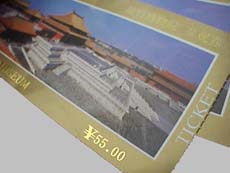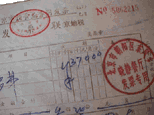Seventy yuan (about $9 US) bought dinner for seven in a family restaurant near
Ma's studio. (Note that the proprietor, on his own initiative, helped London pad
her expense account by writing a receipt for 370 yuan.)
A monetary chasm separates traditional ways from modern living. The conflict
between old and new has torn Beijing asunder. Streams of dusty old bicycles
and one-story brick homes persevere cheek by jowl with traffic-jammed cars
and glittering skyscrapers. The city's maturation is not a process of graceful
growth. The new institutions are simply being hacked out of the existing
society.
Beijing's artists, probably reflecting a divided populace, do not speak with a
unified voice concerning the kaleidoscopic changes that dominate the
Beijing experience. "Go slow" is one mantra often repeated by artists. Others
eagerly reach for the promise of a new society. Well aware that China in this
century has lurched from one extreme to another, these artists hope that modern
international institutions will form the basis for a balanced, stable society.
If you have any information about media art in China, please send it along.
Barbara London welcomes questions and comments about her dispatches. Write to
video@moma.org.
|

